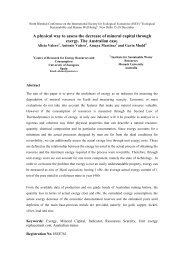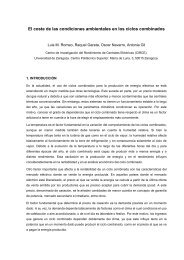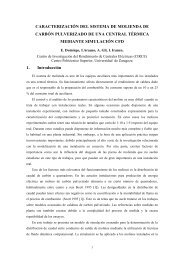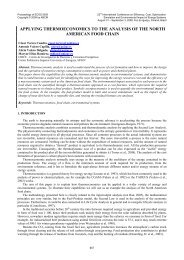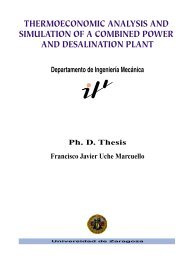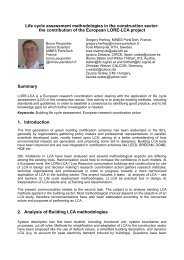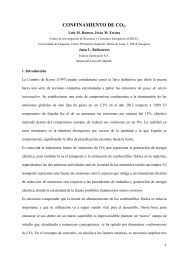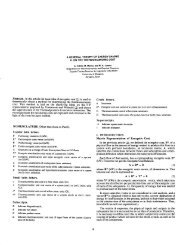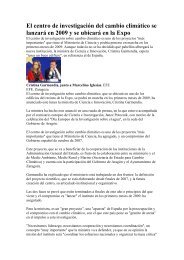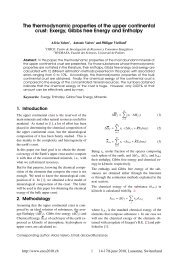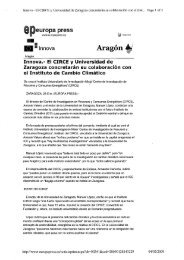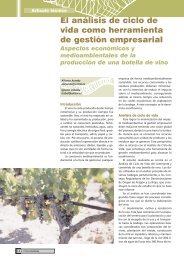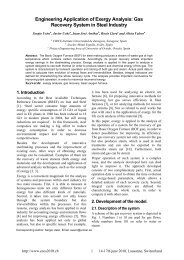CHARACTERIZATION OF A BIOMASS MILLING PILOT ... - circe
CHARACTERIZATION OF A BIOMASS MILLING PILOT ... - circe
CHARACTERIZATION OF A BIOMASS MILLING PILOT ... - circe
You also want an ePaper? Increase the reach of your titles
YUMPU automatically turns print PDFs into web optimized ePapers that Google loves.
milled biomass characteristics analysis: particle size<br />
distribution, moisture content, bulk density, particle<br />
shape factor and chemical composition as function<br />
particle size. The properties variations permit to assess<br />
the influence of the parameters mentioned in final milled<br />
material.<br />
2 <strong>BIOMASS</strong> <strong>MILLING</strong> <strong>PILOT</strong> PLANT<br />
Experimental facility characterization should analyse<br />
the design and operational parameters needed to satisfy<br />
the particle size requeriment with the lowest milling<br />
energy consumption.<br />
The size requirements are fixed by the final energetic<br />
conversion technology and can be expressed by range of<br />
particle sizes, or by more specific granulometric<br />
regulations.<br />
Biomass shows a high heterogeneity in connection<br />
with inherent mechanical and physical properties, and in<br />
reception conditions (moisture content, raw particle<br />
size…). Flexibility in experimental comminution facility<br />
permit to carry out several tests varying:<br />
Type of mill<br />
Equipment combinations<br />
Operational parameters<br />
Biomass mechanical properties represent a relevant<br />
parameter to select the adequate type of mill. Biomass is<br />
mainly composed of non-brittle materials [11] in contrast<br />
with other energetic resources as coal. Several studies<br />
show three types of mills as the most appropriate for<br />
biomass milling: hammer mills, knife mills and also disc<br />
mills in specific conditions [11].<br />
Studied facility is composed of two mills: a hammer<br />
mill and duplex mill [8]. Hammer mill with horizontal<br />
axis and a drive of 11kW comprises 6 hammers arranged<br />
on 3 radial lines. Duplex mill with a drive of 4kW consist<br />
of three hammers in revolution that carry out two<br />
different milling actions: impact breakage of hammers<br />
against particles and breakage by shearing stress between<br />
the hammer, particles and a fixed element inside the<br />
milling chamber.<br />
Grinders are the main equipment in any milling<br />
facility. However, classifying equipments are<br />
incorporated to separate the particles as function their<br />
size. The classifier has operational flexibility which<br />
increases the number of possible mills configuration<br />
allowing the most suitable solid treatment.<br />
Classifying systems select those particles whose size<br />
satisfies the final requirement. Classifier can be used as a<br />
previous stage to separate the particles which satisfy the<br />
size requirement, as a final stage to guarantee the particle<br />
size of final product or as an intermediate stage to convey<br />
the coarse particle again to mill (recirculation flow).<br />
When the upper limit size is fixed, coarse particle can be<br />
eliminated or can be passed by the mill a number of times<br />
necessary to obtain the desired size. In case of lower size<br />
limit, the fine particles are eliminated of the final milled<br />
product.<br />
Milling facility also incorporates auxiliary solid<br />
handling equipment to convey the particles between the<br />
main equipments. At CIRCE milling biomass facility<br />
(e.g. Fig. 1), three different systems are installed to<br />
convey solids. First of all, a belt conveyor is used to feed<br />
the biomass to the mills. Subsequently, pneumatic<br />
conveying, composed of two fans to generate the air<br />
flow, and two equipments (cyclone and bag filter) to<br />
separate the air-particles flow, carries the pulverized<br />
biomass from mills to the final bin. Finally, coarse<br />
particle recirculation is conveyed to mills using an screw<br />
conveyor.<br />
The different combinations between hammer mill,<br />
duplex mills and screen classifier provide five milling<br />
configurations:<br />
1. Configuration A.1: hammer mill<br />
2. Configuration A.2: hammermill and screen<br />
classifier<br />
3. Configuración B.1: duplex mill<br />
4. Configuración B.2: duplex mill and screen<br />
classifier<br />
5. Configuración C: hammer mill, screen<br />
classifier and duplex mill.<br />
Experimental tests in A.1 and A.2 configurations are<br />
focused on the hammer mill analysis:<br />
A.1. Hammer mill.<br />
Particle size is fixed by the internal screen opening<br />
size. Particles pass trough the hammer mill and are<br />
directly carried by pneumatic conveying to the bin. .<br />
A.2. Hammer mill with recirculation to the same mill.<br />
Milled biomass particles in hammer mill are<br />
conveyed to the screen classifier where fines are<br />
separated from the coarse ones. Fine particles are<br />
directly transported to the bin, whereas coarse<br />
particles are conveyed again to the hammer mill<br />
until a suitable particle size is achieved. In this<br />
configuration, the goal particle size is fixed by the<br />
screen opening size in the classifier.<br />
Third and fourth configurations allow the study to be<br />
focused on duplex mill:<br />
B.1. Duplex mill.<br />
As in the A.1 configuration, particles pass trough the<br />
duplex mill before they are being transported by<br />
pneumatic conveying to the bin. Internal screen<br />
determines the final particle size.<br />
B.2. Duplex mill with recirculation to the same mill.<br />
This configuration is similar to A.2. In case finer<br />
particle sizes are needed, this configuration allows<br />
the particle flow to pass several times trough the<br />
mill until the suitable size is reached.<br />
The last configuration is focused on the combination<br />
between both mills with a screening intermediate stage:<br />
C. Hammer mill with recirculation to the duplex mill.<br />
In this configuration (e.g. Fig. 1) the milling and<br />
classifying process are the same as in A.2 configuration,<br />
except for the coarse recirculation. In this case, the coarse<br />
particles are redirected to the duplex mill. The facility<br />
allows both recirculation types.<br />
Configuration changes can be made by means of<br />
removable pneumatic conveying ducts. The combinations<br />
between configurations and internal screens allow to<br />
obtain the suitable particle size in the process.<br />
To control the equipment of the facility, an control<br />
automatic system and data acquisition have been<br />
implemented. The main elements are:<br />
Programable logic Control (PLC): it is the main<br />
control unit. It collets all plant information, and<br />
it take the action on the plant.<br />
Distributed input/output units: they are remote<br />
device, where signals from sensor an signals to<br />
actuators are connect to the PLC<br />
Variable speed drivers: It is the main actuator<br />
in the mill plant. With this we can regulate the<br />
angular speed and the power supply to mill, fan<br />
and others devices.



